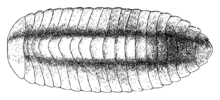Glomeridesmida
| Glomeridesmida | |
|---|---|

| |
| Termitodesmus ceylonicus | |

| |
| Glomeridesmus trinidadensis | |
| Scientific classification | |
| Domain: | Eukaryota |
| Kingdom: | Animalia |
| Phylum: | Arthropoda |
| Subphylum: | Myriapoda |
| Class: | Diplopoda |
| Subclass: | Chilognatha |
| Infraclass: | Pentazonia |
| Superorder: | Limacomorpha Pocock, 1894 |
| Order: | Glomeridesmida Cook, 1895 |
| Families | |
| |
Glomeridesmida is an order of millipedes in the infraclass Pentazonia containing 2 families and at least 31 species.[1] Glomeridesmida is the only living order of the superorder Limacomorpha. Glomeridesmidans are small (less than 15 mm (0.59 in)) and somewhat flattened, and unlike other orders of Pentazonia, are unable to roll into a ball.[2] Ocelli (eyes) are absent.[3]
Adult females in this order have 36 pairs of legs and 21 segments, counting 20 tergites plus the anal shield.[4] Male specimens in this order are rare, unknown for all species in the family Termitodesmidae, and known for only a small number of species in the family Glomeridesmidae.[3] Descriptions of mature males in at least three species (Glomeridesmus spelaeus, G. siamensis, and G. marmoreus) report 35 pairs of legs, including a pair of telopods, and 20 segments, one fewer than the 21 segments found in adult females.[3][5][6] The description of an adult male of another species (G. indus), however, reports 37 pairs of legs, including a pair of telopods, and the same 21 segments normally found in adult females.[7]
Glomeridesmidans occur in the New World Tropics, Southeast Asia, India, and Oceania.[8] Two species are known cave-dwellers, and, like other troglomorphic animals are translucent from loss of pigment. The five known species of Termitodesmus (constituting the family Termitodesmidae) have a commensal relationship with termites.[3]
Classification
- Glomeridesmidae Latzel, 1884 - 31 species; India, South America, Middle America
- Termitodesmidae Silvestri, 1911 - 5 species; India, Sri Lanka, Vietnam
References
- ^ Shear, W (2011). "Class Diplopoda de Blainville in Gervais, 1844" (PDF). In Zhang, Z.-Q. (ed.). Animal biodiversity : an outline of higher-level classification and survey of taxonomic richness. Vol. 3148. pp. 159–164. doi:10.11646/zootaxa.3148.1.32.
{{cite book}}:|journal=ignored (help) - ^ Shelley, Rowland M. (1999). "Centipedes and Millipedes with Emphasis on North American Fauna". The Kansas School Naturalist. 45 (3): 1–16.
- ^ a b c d Iniesta, Luiz Felipe Moretti; Ferreira, Rodrigo Lopes; Wesener, Thomas (2012-11-15). "The first troglobitic Glomeridesmus from Brazil, and a template for a modern taxonomic description of Glomeridesmida (Diplopoda)" (PDF). Zootaxa. 3550 (1): 26–42. doi:10.11646/zootaxa.3550.1.2. ISSN 1175-5334.
- ^ Enghoff, Henrik; Golovatch, Sergei; Short, Megan; Stoev, Pavel; Wesener, Thomas (2015-01-01). "Diplopoda — taxonomic overview". Treatise on Zoology - Anatomy, Taxonomy, Biology. The Myriapoda, Volume 2: 363–453. doi:10.1163/9789004188273_017. ISBN 9789004188273.
- ^ Wesener, Thomas; Wongthamwanich, Nattarin; Moritz, Leif (2021-03-16). "Description of the first species of Glomeridesmida from Thailand (Diplopoda, Glomeridesmida, Glomeridesmidae)". ZooKeys (1024): 137–156. doi:10.3897/zookeys.1024.63678. ISSN 1313-2970. PMC 7987703. PMID 33786005.
- ^ Mauriès, Jean-Paul (1980). "Diplopodes Chilognathes de la Guadeloupe et ses dépendances". Bulletin du Muséum national d'Histoire naturelle (in French). 4e série 2(A): 1059–1111 – via Biodiversity Heritage Library.
- ^ Carl, J. (1942). "Contribution à la connaissance des Limacomorpha -- Essai de morphologie comparée". Revue suisse de Zoologie (in French). 49: 133–167 – via Biodiversity Heritage Library.
- ^ Shelley, Rowland M. (2011). "The Milliped order Glomeridesmida (Diplopoda: Pentazonia: Limacomorpha) in Oceania, the East Indies, and southeastern Asia; first records from Palau, the Philippines, Vanuatu, New Britain, the Island of New Guinea, Cambodia, Thailand, and Borneo and Sulawesi, Indonesia". Insecta Mundi. 196: 1–11.
External links
 Media related to Glomeridesmida at Wikimedia Commons
Media related to Glomeridesmida at Wikimedia Commons Data related to Glomeridesmida at Wikispecies
Data related to Glomeridesmida at Wikispecies- Photographs of Glomeridesmidans
- Discovery of a translucent ancient millipede in a threatened iron-ore cave in Brazil, research from the Museum Koenig.
